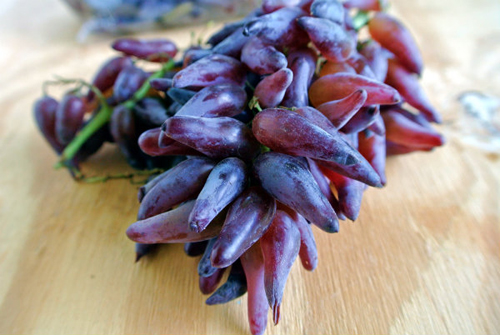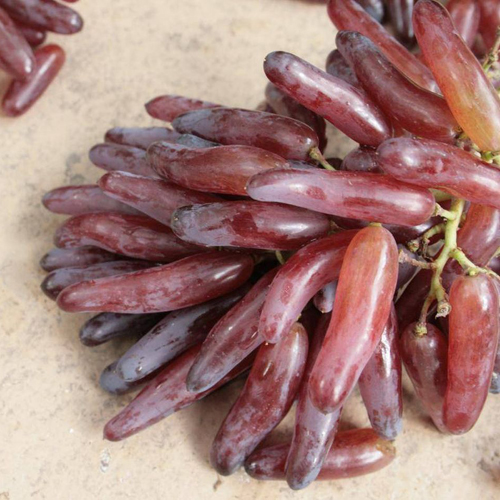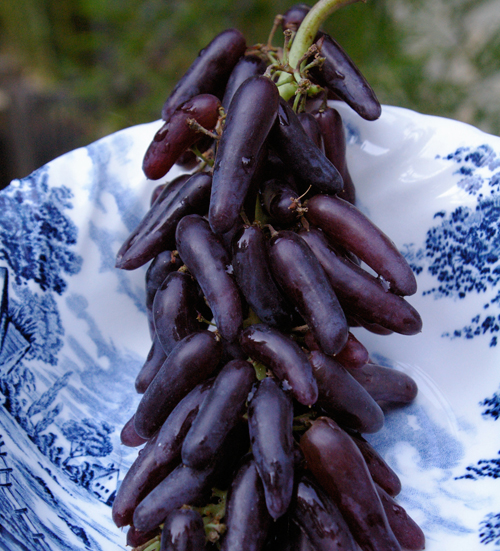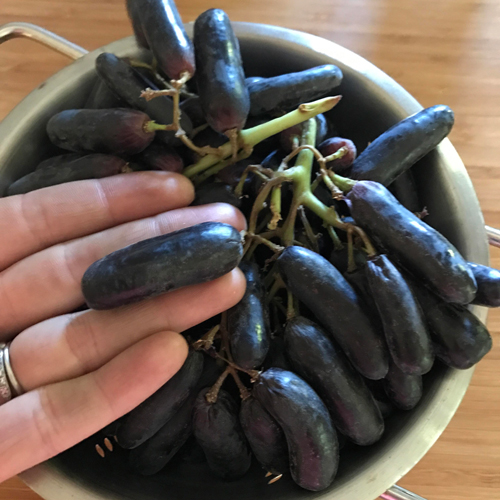Grape variety Witch's fingers
Witch Fingers is a very exotic and uncommon grape of American selection, cultivated in the United States by only one producer - the Grapery company from California. The variety was developed by the private breeding firm International Fruit Genetics after years of trial and error.

The company used raw materials from the University of Arkansas Agricultural Research Station, which had been trying to grow elongated grapes for decades. So, back in 1993, a hybrid was obtained at the University under the working name A-2409, which resembled the current Witch's Fingers, but it did not pass the test due to its susceptibility to powdery mildew, tart skin and unstable yields. But there was one person who really saw potential in him: David Cain, a grape breeder at International Fruit Genetics.
After several attempts by Kane to gain access to the species, his efforts were crowned with success, and the A-2409 was sent to IFG to work with him. There, the hybrid was crossed with a certain Mediterranean variety, the name of which was not disclosed. The result is a variety with dark-colored berries, original in shape, while devoid of those technological shortcomings that were inherent in its parental form. According to the breeder, the hybridization that led to the appearance of his brainchild was carried out in 2002, and the first bunches appeared in 2004. After that, it took several years to grow enough vines to get a test batch for consumers.
The novelty was presented to the general public in 2011. By this time, all rights to her had passed to Grapery, which specializes in the cultivation of unusual varieties of fruits. Appearing on sale under the brand name "Witch's Fingers", our hero caused a violent reaction among consumers. The unique shape and excellent taste of the berries have made it a premium product among high-class chefs and gourmets. The supply of this grape is still extremely limited because it is grown in very small quantities. In some stores, it sells for $ 7 a pound (over $ 15 per kilogram).

It is worth noting that in the relatively short time that has passed since its inception, the variety has already gone through several renaming. At first it was supposed to be called "Chile" for its similarity to the pepper variety of the same name. However, the manufacturer's marketers did not like the name, as they thought that grapes with the name of hot pepper would cause confusion among consumers. Then the name "Witch's Fingers" was chosen, but later the management of the company did not like it, and for several years now our hero has been presented on the consumer market as "Tear Drops". At the same time, it is possible that in the future, Grapery employees responsible for sales will suddenly remember that blue tears are, to put it mildly, not the best way. So a new rebranding is quite possible in the coming years.
Agrobiological characteristics
According to information available in the public domain, the bushes have a high vigor. The leaves are large, heart-shaped, consist of three or five lobes with an average degree of dissection between them. The leaf surface is dark green, reticulate-wrinkled, the dorsum is slightly pubescent. Upper sidecuts of moderate depth, open, most often in the form of a retraction angle. The lower cutouts of many leaves are absent, some may be barely outlined. The petiole notch is open, vaulted with a flat or pointed bottom. Petioles are long, pinkish-green. The denticles along the edges of the plate are different in shape and size, while having smooth edges and sharp tops. The flowers are bisexual, suggesting a good degree of pollination and the absence of underdeveloped berries.
Bunches of grapes are large, weighing 600-800 grams, the most outstanding can reach one and a half kilograms. They are cylindrical-conical or cylindrical in shape, the density is low. The combs are herbaceous, long, of medium thickness, light green in color. The grapes, thanks to their free arrangement, do not undergo deformation and do not damage each other during growth and maturation. The most memorable characteristic of the variety is the shape of its berries. They have an oblong tubular appearance with pointed, curved tips. The coloration can vary between deep purple, blue and nearly black. The surface of the grapes is covered with a thick layer of bluish prune.

The berries are very large in length - up to 45-50 mm, the weight can vary from 7 to 15 grams. According to those who have had a chance to try "Witch's Fingers", they have to be eaten in a few bites, since it is impossible to eat them whole. The pulp is tender, juicy with a bright harmonious taste, reminiscent of a plum, and light fruity tones in the aroma. The sugar content of the juice of grapes is high, reaching 18-20 g / 100 ml when fully ripe, but the content of acid and tannins, on the contrary, is very modest, which determines the taste of the fruit, which is very rich in sweetness. Thin skin and good structure of the flesh allow you to feel a pleasant click when eating while biting the berries in half. The seeds are small, in many berries they are absent at all, which also has a positive effect on the already excellent tasting ratings.
Basically, the harvest of this variety is used for fresh consumption, making a lasting impression on consumers. The bunches are packed in individual branded bags of the manufacturer, and in this form are delivered to the US retail network. A significant proportion of the grapes are used in cooking, enjoying success with many eminent chefs in the country. According to them, "Witch's Fingers" goes very well in dishes with almonds, walnuts, pistachios, hazelnuts, pork, poultry, duck, rosemary, fennel, fennel seeds, mint, yogurt, blue and goat cheese. But this variety is not suitable for long-term storage, and therefore it is on sale only during harvesting. The bunches also do not shine with transportability, and therefore the manufacturer honestly warns that some of the grapes in the package may crumble from the ridge.
The grapes ripen early. In his homeland, California, harvesting begins in mid-July and continues until the end of August. Early harvesting dates suggest that the sum of active temperatures required for the variety to ripen the crop is not too high, and therefore it is theoretically capable of being introduced in regions with a moderately warm climate. There are no objective data on the frost resistance of the variety, and those that are available are very doubtful. In the mild California climate, the bushes, judging by the photographs, are cultivated on a high trunk without shelter for the winter, but how they will behave at low winter temperatures is anyone's guess.

The yield of the form is moderate, but this is more than offset by the high price of Witch's fingers, caused by the rush of demand from buyers. For each berry to achieve a magnificent aroma, juiciness and sweetness of taste, the bunches are left on the vine for as long as possible. When heavy rains begin in California during the ripening season, most growers quickly harvest all the grapes at once. Grapery covers their plantings with recycled plastic to protect the fruit from rainstorms and marauding starlings, continuing to selectively harvest only the sweetest bunches until they run out.
Given the lack of information about the agrobiology of the variety, it is pointless to talk seriously about the features of the technology of its cultivation today.It is only worth noting that, according to Grapery CEO Jim Beagle (Jim Beagle), this variety is one of the most difficult to manufacture. But be that as it may, I would like to hope that over time, "Witch's Fingers" will become available for cultivation and wine-growers of our country, after which, based on the results of the variety testing, it will be possible to share specific recommendations. Until then, we can only contemplate the magnificent bunches in the pictures, and the lucky ones have the opportunity to enjoy the wonderful gastronomic characteristics of these berries.








